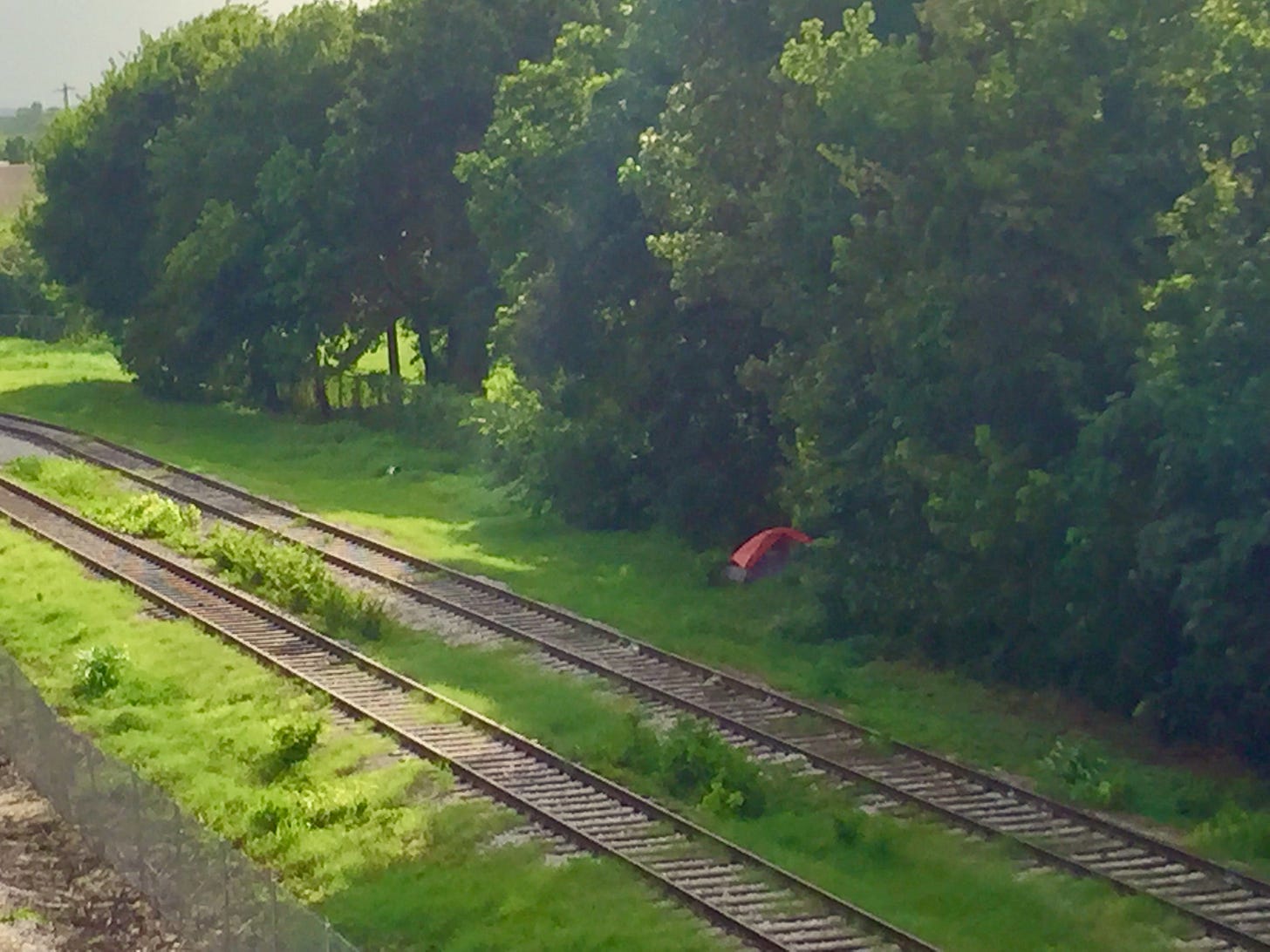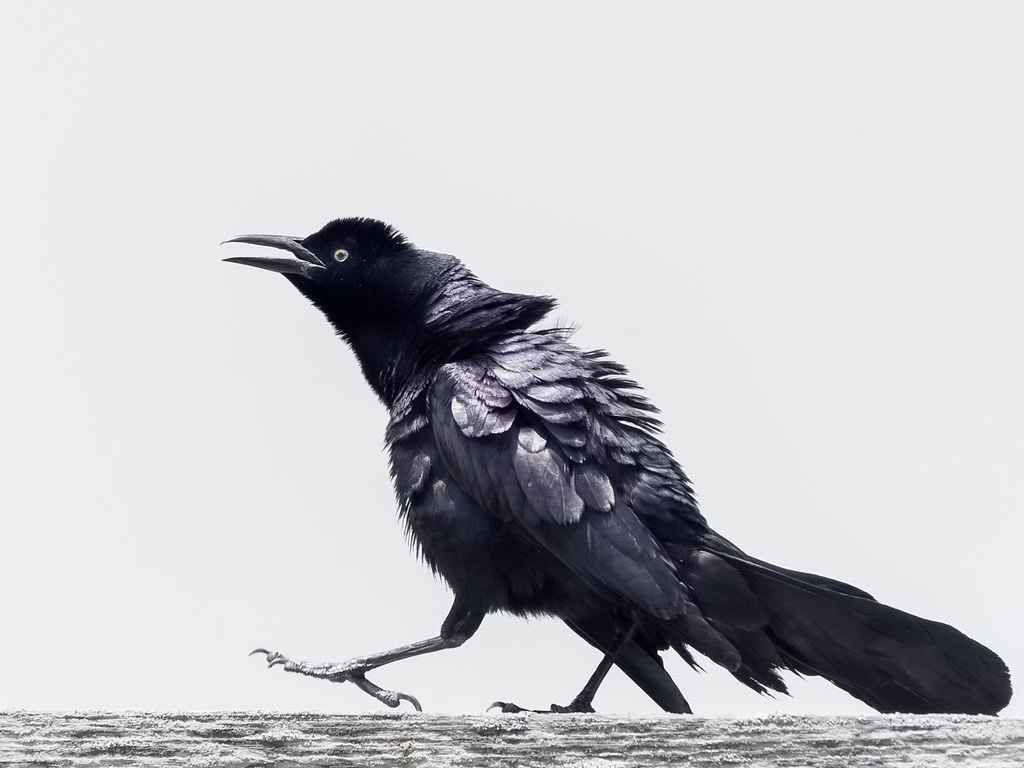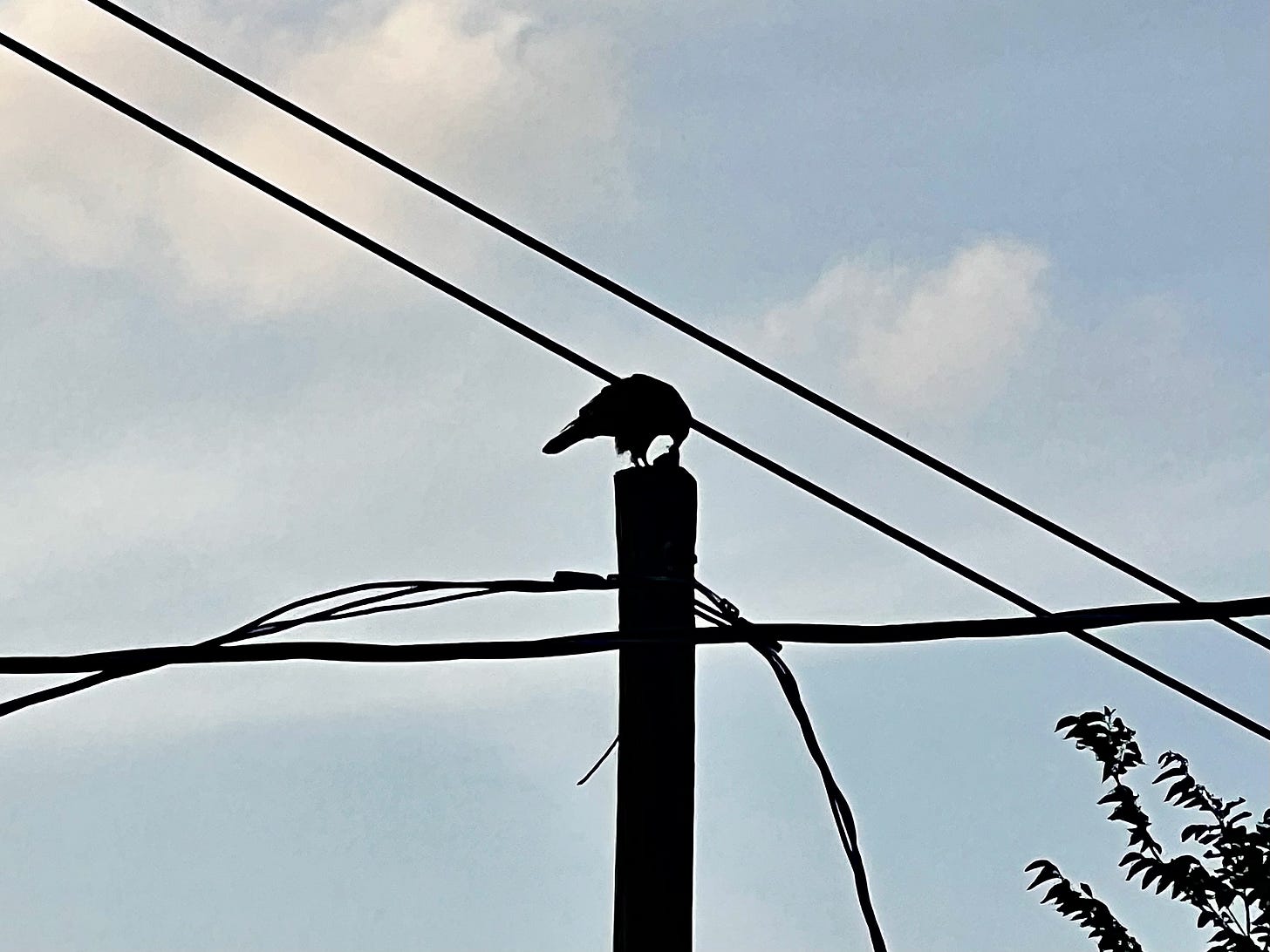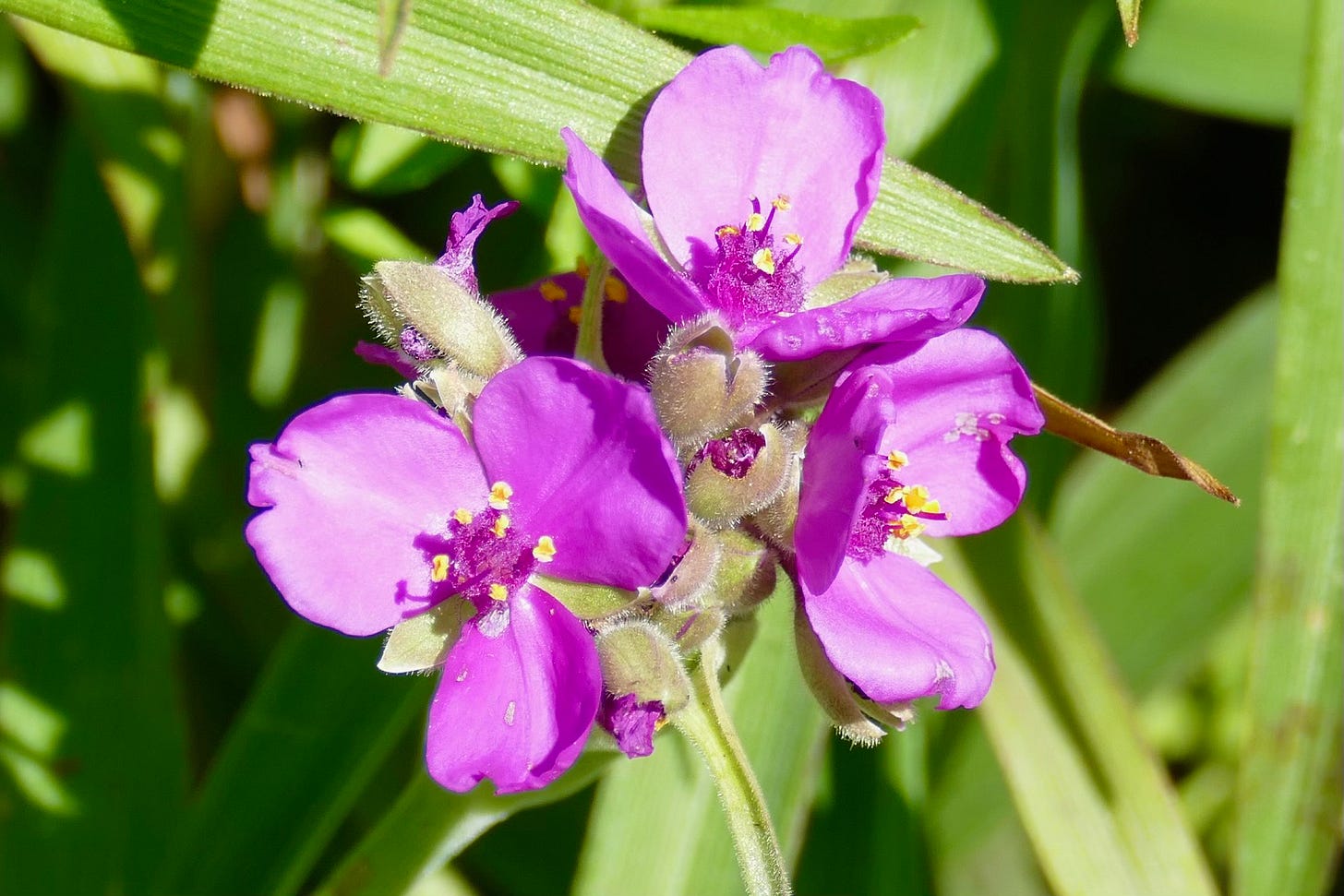Ahuizotl's Gift
No. 147
I saw my first real sign of spring on Abraham Lincoln’s birthday, a date and figure I don’t usually associate with the season of flowers and frolic. It was a grackle chasing down a caracara, above an old overpass on the road into downtown. They were easy to identify, even glimpsed from a moving car at a distance farther than my after-the-fact crime scene sketch suggests, because both birds have such characteristic profiles. A common scene when the weather starts to warm around here in mid-February, and the birds get busy building nests.
When I see bird mobbing in the city, it always makes me wonder where the nest is. Birds are good at hiding in plain sight, in densely urban zones like the one where I saw the morning rush hour showdown. The bridge I saw the birds from is pre-war infrastructure, passing over a freight line that’s probably been there for more than a century. Look down and you’ll see how tall the trees grow along the right of way, creating a little interstitial woods behind the municipal bus yard and the shuttered branch library, where the tall fences mostly succeed in keeping the people out.
Great-tailed grackles like to nest in big trees, but not in forests. Their ideal site to raise their young is in the high crook of a live oak, where they make a shelter of sticks, sometimes mixed with manmade materials. The nesting tree needs to be near an expanse of pasture or lawn. The clump of tall trees along the train tracks, within a block from a big grocery store where the dumpsters and trash cans fill with food trash, seems like a spot worth fighting for. And general territory may have been all the grackle was chasing the caracara off from, as it seems too early for them to be actively breeding. But the seasons have been changing in other ways, and the grackles know how to adapt to the world we made.
So do the house sparrows, who I found last week nesting in the ruins of an abandoned novelty lighting factory here at the edge of East Austin, just a few blocks east of where I saw the grackle-caracara spat. I’ve noticed the sparrows’ presence there for years, in the shelter provided by the metal canopy that covers the old loading dock along the backside of the building. An area covered in graffiti, and seemingly devoid of food. The factory was active in the 80s, before that kind of fabrication moved offshore. In the early 2000s, when Bush the younger was president, it served as a staging area for the Secret Service. A dozen years ago I found single cufflink there by the sidewalk, embossed with the seal of the presidential retreat at Camp David.
You can’t help but notice the sparrows if you walk by there in the early morning, when their manic flittering energy fills the zone behind the fences. The quiet cacophony of little songs, the comings and goings in the cool air. But they are such commonplace birds, ever-expanding colonists like us, and the site is such a slice of urban negative space, that I never really stopped to take a closer look despite more than a decade of regularly walking past there. Only last week did I take notice of just how the sparrows have found shelter in that spot.
They actually live in the canopy itself. The corrugated metal roof is lined on the inside with some kind of particle board, which has begun to deteriorate in long holes that roughly track the lines of the corrugation in the metal panels. Providing perfect, sparrow-sized nesting spots. Big enough for a massive colony to fill the echo chamber with song, in a spot formerly filled with the reverse warnings of semi trucks.
As you look around, you can begin to see all the food sources. Like in the edges of the light industrial lots across the street, where sunflowers and other seed-bearing plants grow tall along the fences and sheds, and native vines crawl up the fences.
The sparrows are invaders from England, like our colonizing forbears, and the starlings who nest in the billboard across the street behind ads for plaintiffs’ lawyers (currently featuring my wife’s favorite, the champion of the injured whose tagline is GET DANG!). English sparrows were first introduced in Brooklyn in 1851, and quickly expanded to cover the continent, becoming one of our most common and least-loved birds. In no small part because of their ingenious gifts for adaptation to urban nesting sites.
Maybe it is their weirdly punk charisma that has let the great-tailed grackles get adopted as a truly native bird worthy of adoption as some local culture mascot, even though they may not have occupied these parts as long as the sparrows, or even that old freight rail line. Great-tailed grackles have only been in Texas since the end of the Civil War, and in Austin since the turn of the last century. Their native habitat is the edges of Central American jungles. Which it may have stayed, had not Moctezuma’s uncle Ahuizotl taken such a liking to them that he dispatched the long-distance merchants known as pochteca to bring them to the Valley of Mexico.
We know this because of Bernardino de Sahagun’s General History of New Spain, compiled by the friar in the mid-16th century at the Royal College in Tlateloco. One of Sahagun’s fellow researchers and contributors was professor Antonio Valeriano, who had married Moctezuma’s granddaughter, the princess Isabel Huanitzin. Contemporary scholars speculate that these kinds of living family connections to the immediate pre-Columbian past may be how many of the stories that ended up in the General History were collected. Including the story, in Book Eleven, of the origins of the bird known to the Aztecs as Teotzanatl—a name that means “divine or marvelous grackle,” and signifies the bird’s exoticism.
Perhaps Ahuitzotl wanted access to more of those iridescent blue-black feathers of the male grackles. Maybe he liked to watch the Jagger-esque mating struts of the males, or enjoyed the sounds of their crazy collection of noise band vocalizations. With an army of specialized bird smugglers at his disposal, long-distance agents who knew how to disguise themselves as locals in exotic lands and had specialized skills in tracking and trapping the wildlife, he brought flocks of the grackles to Tenochtitlan. Where they quickly established, and expanded around Central Mexico. And within five centuries, across the Rio Grande, then up the Colorado, and now much deeper into the North American continent.
Now when I read about how well adapted grackles are to farm fields and cities, I find them teaching me lessons about how much unlikely continuity exists between the imperial cities and croplands the conquistadors found, and the ones we inhabit. And about how much of what we denominate as “natural” is animal adaptation to the world we remade in our extraction of its bounty. Like the bird that has been stealing tortillas for five-hundred years.
Further reading
For more on the curious anthropogenic natural history of the great-tailed grackle, Quiscalus Mexicanus, check out Paul Haemig’s 1978 Biotropica paper “Aztec Emperor Auitzotl and the Great-Tailed Grackle,” and his 2012 piece in The Auk on the provenance of the historical account, both available at JSTOR. And for a more contemporary perspective on the charisma of the birds, see Austin writer Asher Elbein’s excellent piece at Audubon, “In Praise of the Great-tailed Grackle, A Bird That Doesn’t Need Your Respect.”
On the evolutionary surprise watch, Popular Mechanics has a fascinating piece about the adaptation of wolves to the Chernobyl Exclusionary Zone, where the alpha predators seem to have adapted in a few generations to survival atop an irradiated food chain.
And on the rewilding watch, the NYT last week had a fascinating piece about golf courses being left to their own devices, and how hard it is for some people even in the midst of our climate and biodiversity crisis to see the beauty in that natural reclaiming of our most artificially manicured green spaces.
If you need a big book to take out to read in the field of February flowers, or get you through the last few weeks of winter up north, check out The Book of Love, the first novel from Field Notes friend and Pulitzer finalist Kelly Link, which came out the day before Valentine’s Day. I picked up my copy that day, at Austin’s Book People, and was immediately entranced when I started reading it that night. Kelly is one of our greatest living masters of the short form, and it’s tremendously exciting to see how she adapts her uniquely magical blend of literary fabulism to the capacious form of a big doorstop of a novel. Highly recommended. And available for order directly from Kelly and her husband Gavin Grant’s own bookstore in Northampton, Book Moon.
For your fall reading list, the pre-order pages are finally appearing for my own new book, which expands and synthesizes the material of this newsletter (and more) at book length (with a few photos). The final title is A Natural History of Empty Lots: Field Notes from Urban Edgelands, Back Alleys and Other Wild Places. “A genre-bending blend of naturalism, memoir and social manifesto for rewilding the city, the self, and society,” per the publisher. The cover will be revealed soon, and in the meantime, you can get your copy in the queue now if you are so inclined. Forthcoming October 15, 2024 from Timber Press, an imprint of Hachette Book Group.
And if you’re in Austin and interested in learning more about the conflict between local wild spaces and development pressure, check out the petition in the lawsuit filed Friday by the River Bluff Neighborhood Association, PODER and the Save Our Springs Alliance against the Mayor, City Council and City Manager to try to protect the Colorado River Wildlife Sanctuary and the stretch of wild urban river that runs past it from a giant new mixed-use development enabled by what the plaintiffs argue was a series of illegal and ultra vires zoning decisions. I was happy to be able to contribute to the work on this matter, and I think the legal theory of the case is a winning one. Wish us luck.
Early bloomers
This week the local temperatures finally started pushing into the high 70s, and come Saturday, the first flowers appeared, especially from the native plants that flourish in disturbed areas, like the sand and sun-loving bluebonnets, which are lush this year, and the shade-loving spiderwort that grows weirdly well in the trash-laden bluff at the back of our lot. The spiderwort appears in several variants here, all shades of purple, and its flourishing in the aftermath of our blight, appearing at the very earliest signs of spring, is always a powerful reminder of the resilience and recovery embedded in the idea of spring.
Writing the first sentence of this post got me wondering about the etymology of the word “frolic,” which confirmed its Anglo-Saxon derivation, and its common roots with Frühling, the German word for spring. “Make merry, have fun, romp playfully” is not a bad way to greet the new week and the beginnings of the new season.











Always wondered about the history of the Grackles, a bird I’d never encountered before moving to Austin. - As always thanks for the education.
Good luck with the lawsuit! Exciting news to see SOS and PODER working together!
Also thanks for link to the ungolfing the golf couses NYT article! Good stuff!